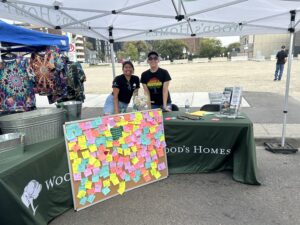By Kali Attridge, Wood’s Homes School Support Counsellor.
Bullying Awareness Week (November 14 to 18, 2022) is the third week in November. The week provides an opportunity to promote awareness and understanding of bullying and its impacts.
When discussing bullying, our minds often jump to Pink Shirt Day and “zero-tolerance policies” that have continued to develop over the last few decades. Bullying is often labelled as negative behaviour, encompassing “malicious” or “mean” characteristics. All of us can agree that bullying has profoundly negative impacts on children and youth and that it is necessary to work towards ending it. Bringing awareness and zero-tolerance policies for bullying are a few of the ways that schools and organizations work towards eradicating these behaviours.
Although these zero-tolerance policies and Pink Shirt Day have existed for years, we all still work in a world with children and youth where we witnessing clients engage in bullying behaviours on a relatively regular basis. So, what needs to be shifted in the conversation?
Bullying by definition is “a form of aggressive behaviour in which someone intentionally and repeatedly causes person injury or discomfort” physically, emotionally and/or psychologically.
When I hear about bullying, I think about the way I have observed it in classroom settings, and my own approach of trying to explore the young person’s actions or words. Building capacity for change requires that I explore the deeper reasons and ask: Why?
When I have witnessed bullying behaviour by students in the past, I held space for those children to identify what need was being met in these behaviours. Most often, children and youth identify that they engage in bullying type behaviour as a level of protection for themselves and a defense mechanism. Bullying is so clearly, just another example of a pain-based behaviour.
So, now what? Understanding that bullying comes from a place of defense and is a method of protection can be helpful to know when working with children one-on-one, but how cam I continue to acknowledge this while working within a group milieu?
In my perspective, this comes back to foundational trauma-informed practice. I reframe bullying behaviour. I see it not as children being “mean” or “malicious” to one another, but as a pain-based behaviour that is meeting a need. This allows me to address it on a foundational level by focusing on the establishment of safety and security within a classroom; allowing children to feel safe to discuss their emotions and feelings; and allowing them the opportunity to be vulnerable with one-another.
What I have found helpful is starting from a place of acknowledgement and validation. I am not accepting these behaviours or condoning them, but I am giving space for children to feel heard through what their actions are telling me. I continue to ponder how we can simultaneously offer support those who are being targeted by these behaviours, but in a way that does not isolate those who bully.
For me, it goes back to promoting safety in the classroom by establishing consistency, empowering resilience and increasing self-esteem. Bullying has existed within school dynamics for many years and unfortunately will continue to be present in working with children and youth.
I do think we are making great strides forward by reframing the conversation and making meaningful change in reducing bullying beahviours — not only to support and make changes for those who have been bullied, but also those who engage in bullying behaviours.




